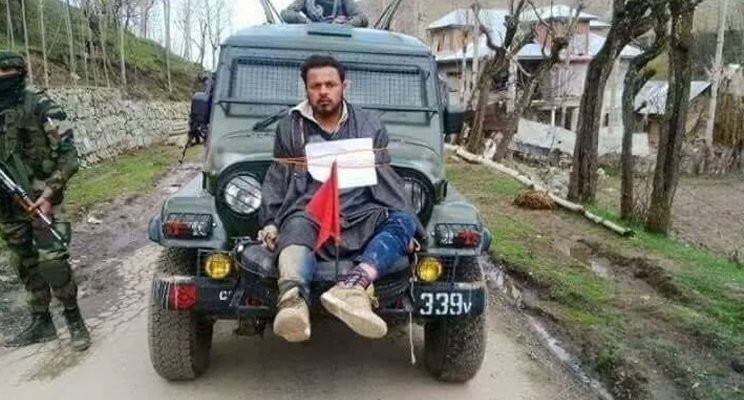
By- Prof. Dabiru Sridhar Patnaik, Director, Centre for Post Graduate Legal Studies, Jindal Global Law School
The Indian Army using a human shield in Kashmir to evade stone-pelters has caught significant media attention, leading to a number of questions under the purview of national and international laws.
What is the relevant body of international law that deals with the prohibition of using human shields, and under what circumstances are these conventions applicable? What is the applicability of such a law in India’s context?
The Indian Army is deployed in the hinterland of Jammu and Kashmir for counter-insurgency operations. However, this particular incident in Budgam was certainly not related to a counter-insurgency operation.
International Law Prohibits Use of Human Shields
According to the information available in the public domain, the Army had been called in by other security forces that were deployed to safeguard poll officials, under attack from a mob of approximately 900 stone-pelters. The Army personnel used an individual as a human shield to quell the situation.
It is worth emphasising that for any such examination or relevant scrutiny, it is important to understand the nature of human shields and contextualise the situation to understand the application of international law.
Whether it is a situation of an international armed conflict or a non-international armed conflict, including situations of riots and internal disturbances, international humanitarian law makes a distinction between military targets and civilian targets, and through its Geneva Conventions prohibits the use of human shields in any form.

Geneva Convention Calls for Protection of Civilians
Geneva Convention IV, read with additional protocol I, refers to human shields as ‘civilians or protected persons, whose presence or movement is aimed or used to render military targets immune from military operations’.
While this is a principle that is relevant to international armed conflicts, there is no specific prohibition of human shields under the law of non-international armed conflicts.
Additional protocol II to the Geneva Conventions necessitates the need for general protection of civilian population against the dangers arising from military activities.
‘Use of Civilians for Military Objective Is Forbidden’
According to reports of the diplomatic conference leading to the second additional protocol, the proposal for inclusion of the rule on human shields did not have international concurrence.
According to the International Committee of the Red Cross Study on Customary International Law, a general practice accepted as law, ‘the use of human shields in any form of armed conflict is prohibited or is considered a violation of customary international law’.
The San Remo Manual on the Law of Non International Armed Conflict, states that ‘the use of civilians, as well as captured enemy personnel, to shield a military objective or operation is forbidden’.
The other sources of international law that ban use of human shields is the Rome Statute of International Criminal Court with particular reference to international armed conflicts.
The General Assembly, the Security Council and the UN Office of the High Commissioner for Human Rights have also adopted numerous resolutions condemning the use of human shields.
Legal Vacuum on Human Shields in Internal Conflict
There is no treaty-based mechanism for prohibition on use of human shields in internal conflicts. International human rights law principles on the right to life can be of guidance here.
Hardly anyone would dispute the nature of express legal prohibition of use of human shields in any kind of a conflict situation.
In practice however, there is a complex, dichotomous situation of ‘voluntary and involuntary human shields’ as well as ‘defensive and offensive human shields’.
As for the application of law for voluntary and offensive human shields, there are differing opinions and interpretations that vacillate between considering such human shields as individuals partaking in hostilities, and thus not worthy of legal protection.
In certain cases, proportionality is factored in so that harm or damage to them could be minimised, as they are indirect agents and victims of some form of aggrandisement.

India Should Declare Domestic Use of Human Shields as Illegal
The principle of proportionality imposes restraints on parties in a conflict from launching attacks that would harm civilians. But voluntary shielding poses a challenge to this principle in practice.
Situation becomes even more complex when one has to deal with circumstances in which distinction is to be made between combatant and non-combatant human shields.
It’s a tedious task to distinguish between enemy and target in an internal conflict where there is an overlap with civilian population. Obviously, as such conflicts move to populous civilian localities, there could be an increased involvement of civilians in such activities as well.
The international law on condemning human shields is clear, the situation in India warrants the need to consider domestic use of human shields as illegal.
It is an important issue that needs engagement from all relevant stakeholders. There is a need to reconcile disparate views related to the issue.
(The article was originally published in the Quint)
